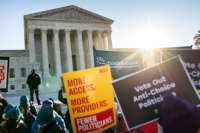
The United States Supreme Court appears ready to completely undo or drastically weaken decades of established precedent protecting abortion rights.
On Wednesday, the High Court heard arguments regarding a restrictive Mississippi law that bans abortions after 15 weeks of pregnancy. In filing its initial briefs earlier this year, Mississippi Attorney General Lynn Fitch laid out a direct challenge to Roe v. Wade, a Supreme Court ruling from nearly 50 years ago that recognized the right to abortion access in every U.S. state.
The Court’s conservative majority spent much of their time on Wednesday discussing whether to take a narrow view of the case — that is, deciding whether the 15-week abortion ban was constitutional — or to take a broader consideration by exploring whether Roe should be upended completely.
Chief Justice of the Court John Roberts opined that upholding the 15-week ban would not be a “dramatic departure” from the stipulations in Roe, and called for keeping the case focused on the ban. Meanwhile, Justice Brett Kavanaugh signaled that he might vote to dismantle the decades-old decision, arguing that the Court should leave the issue to states — a scenario which could leave millions of Americans unable to access a routine medical procedure that has the potential to be life-saving.
Justice Samuel Alito, one of the most conservative members of the Court, said “the only real options” for him and his colleagues to consider rested on whether to affirm or overrule Roe, which he firmly believes should be overturned.
While those considerations were taking place, U.S. Solicitor General Elizabeth Prelogar argued on behalf of the federal government in favor of keeping Roe in place, warning that the Supreme Court has never revoked a constitutional right it had previously extended. All three liberal bloc justices also voiced their opposition to undoing or weakening Roe, with Justice Sotomayor saying that doing so would destroy the reputation and integrity of the Court.
“Will this institution survive the stench that this creates in the public perception that the Constitution and its reading are just political acts?” Sotomayor asked. “I don’t see how it is possible.”
Undoing Roe would have a devastating effect on reproductive rights and abortion access in the United States, endangering people who are seeking abortions across the country. If Roe were undone, analysts have concluded, it’s likely that 22 states would either ban abortions completely or put dangerously restrictive limits on the procedure.
Social media users were quick to express their anger at the Court, with many noting that Democrats in Congress should act now to ensure that reproductive rights are protected.
“Democrats could pass national legislation to protect abortion rights,” said journalist Judd Legum, “but will not because several Senators don’t want to make an exception to the filibuster so they will let Supreme Court justices (who were only confirmed via an exception to the filibuster) gut abortion rights.”
Washington Post opinion writer Jennifer Rubin said that if the Court strikes down Roe, it is imperative that Democrats end the filibuster to immediately pass a law protecting abortion access.
“Once the Court eviscerates abortion rights (as it did with voting rights) perhaps the Dem Senate will create an exception to the filibuster for protection of constitutional rights, put Roe into statute and pass voting rights,” Rubin tweeted. “Biden better use famed negotiating powers on [Virginia Democratic Sen. Joe] Manchin.”
Other journalists noted that none of this would have been possible were it not for the reckless way that former President Donald Trump was able to appoint anti-abortion justices to the Court.
“It’s wild that a third of the Supreme Court was appointed by a man who attempted to overthrow the United States government, and we just continue to let those judges hand down decisions,” wrote Ian Millhiser, senior correspondent for Vox.
Reproductive rights activists expressed dismay after arguments wrapped up — and warned about the possibility that conservative justices wouldn’t stop at abortion.
“They are coming for all of it — and quickly,” wrote Katie Buie, national communications director for pro-choice organization NARAL. “Every aspect of reproductive freedom is at stake.”
Writer Jill Filipovic also noted that anti-abortion laws — including restrictions like the ones Mississippi lawmakers have been trying to enforce — are typically associated with places that have worse health outcomes.
“The states with the strongest anti-abortion laws also boast the highest rates of infant mortality,” Filipovic wrote. “A woman who lives in a ‘pro-life’ state is much likelier to die during pregnancy, in childbirth, or soon after than a woman in a pro-choice state.”
With arguments now completed, the Supreme Court will meet in private conference over the next few days, taking a vote amongst themselves to determine the case’s outcome. After that, a senior justice in the majority opinion will assign someone to write the opinion of the Court, or take writing duties themselves, with dissenting opinions by other justices being assigned as well.
In most cases, it takes the Supreme Court about three months to issue a decision. However, given the gravity of this case in particular, the Court will likely issue its final order in June or July.
This post was originally published on Latest – Truthout.




